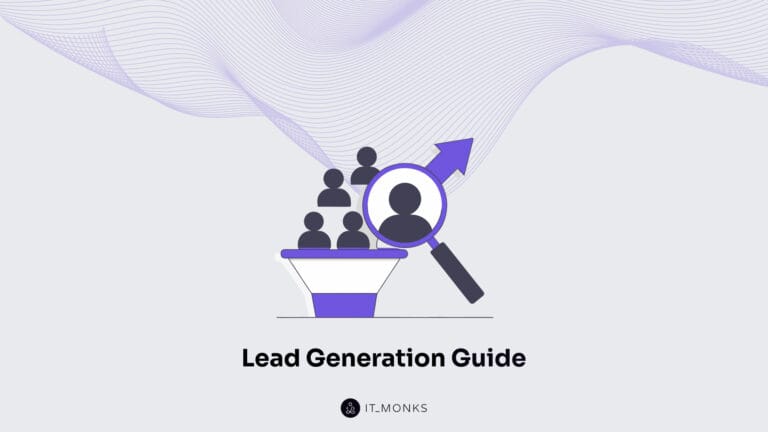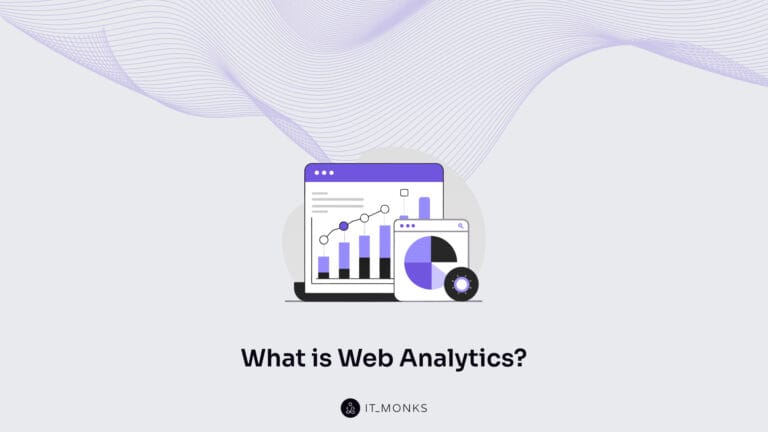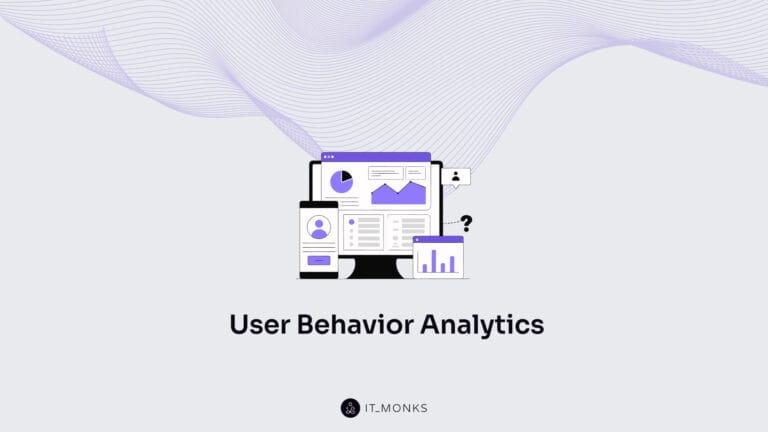Enterprise Cloud Hosting
Table of Contents
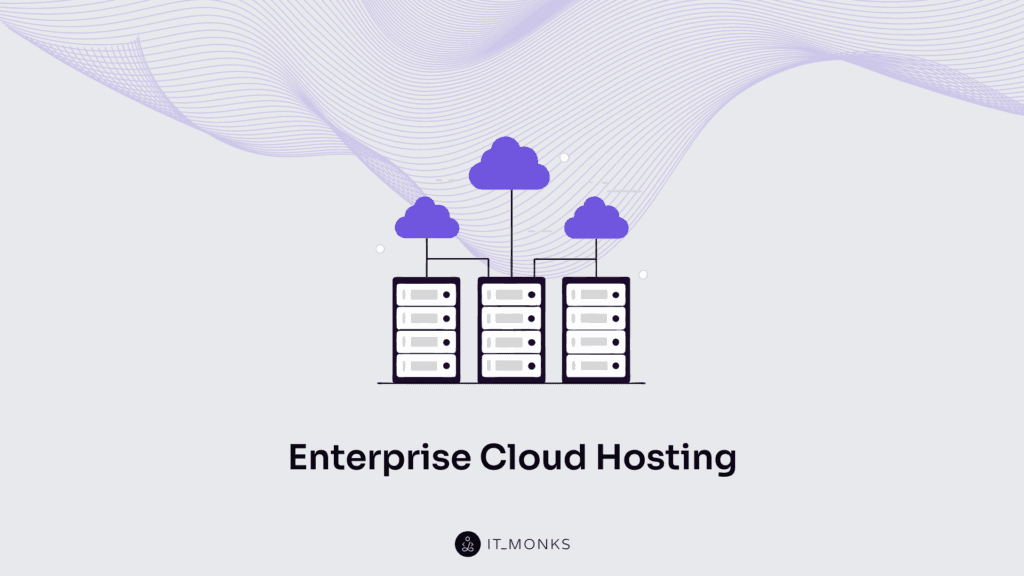
Enterprise cloud hosting provisions infrastructure scalability and virtual resource isolation as foundational requirements for compliance-ready enterprise website environments. Enterprise cloud hosting orchestrates cloud-native architecture within virtualized environments to support the development and operation of high-availability digital platforms.
It safeguards workload distribution across isolated compute layers, maintaining deployment velocity and operational continuity within the enterprise website infrastructure. Enterprise cloud hosting supports elastic compute scalability via dynamic resource allocation, isolating enterprise-grade workloads across virtual layers to maintain SLA-backed uptime and service integrity.
Within the enterprise website development lifecycle, cloud hosting enables governance enforcement, network segmentation, and identity management alignment across federated access layers. It complies with multi-tenant segmentation protocols and governance control standards to isolate workload distribution while maintaining unified policy enforcement across hybrid deployment environments. Enterprise cloud hosting provisions Infrastructure as Code (IaC) to support structured configuration management across virtual resource pools and hybrid deployment models.
As enterprise websites integrate modular systems, such as enterprise CMS platforms and ERP solutions, Enterprise cloud hosting optimizes orchestration workflows by provisioning scalable deployment layers and resource segmentation. The cloud infrastructure accommodates redundancy, cross-region failover, and compliance-based data residency policies, ensuring regulatory continuity and consistent high availability throughout content delivery pipelines.
Enterprise cloud hosting enables secure enterprise website operations by aligning resource orchestration with regulatory frameworks, identity governance, and elastic deployment integrity. As a scalable backbone for digital continuity, it sustains enterprise-grade application reliability and operational resilience across dynamic web environments.
What is Enterprise Cloud Hosting?
Enterprise cloud hosting defines a virtualized, policy-driven, and SLA-governed infrastructure that serves enterprise websites and systems. It delivers geo-redundant clusters, orchestrated VM provisioning, and identity-managed isolation to support the continuous deployment demands of modern enterprise web infrastructure.
Provisioning occurs through orchestrated VM instance layers that enforce segmented cloud tenancy and guarantee multi-tenant resource isolation. Runtime environments are governed via identity and access policies, enabling fault containment and secure system partitioning across distributed compute zones. SLA-backed uptime (e.g., 99.99%) is achieved using redundant storage, load-balanced infrastructure, and dynamic orchestration frameworks.
Automated provisioning engines allocate compute resources while supporting multi-region failover, elastic scaling, and VM orchestration. This architecture integrates infrastructure-as-code and identity governance, aligning seamlessly with hybrid and multi-cloud delivery pipelines.
Cloud-native deployment pipelines structure automated release workflows that enforce compliance policies, access boundaries, and performance thresholds. These pipelines empower zero-downtime deployments and support regulatory alignment with SOC 2, ISO 27001, and HIPAA.
Security and scalability are reinforced through rigorous control of infrastructure attributes, tenancy isolation, resource orchestration, SLA enforcement, and compliance tracing. The result is a resilient, distributed, and policy-aligned hosting environment built for mission-critical enterprise web platforms.
Infrastructure Control
Infrastructure control in enterprise cloud hosting enforces how compute, storage, and network resources are provisioned, segmented, and governed for enterprise websites. It functions as the policy-execution layer that orchestrates physical and virtual infrastructure, anchoring compliance, uptime, and workload integrity.
Cloud management layers govern resource pools through policy-driven provisioning and tenant-level enforcement. They orchestrate workload execution across bare-metal nodes and virtual environments using control plane segmentation to enforce system visibility, access boundaries, and operational separation.
Enterprise hosting architecture enforces infrastructure control through dual domains: hardware-level exclusivity and software-defined isolation. It maps workloads to dedicated physical nodes and segments compute operations through logical partitioning, ensuring strict governance without compromising resource elasticity.
Hardware resource pools are provisioned using resource affinity mapping and policy-driven control. Bare-metal provisioning enables dedicated tenancy, securing performance-sensitive applications while reducing cross-tenant exposure.
Virtualization systems isolate tenants using hypervisor-layer enforcement and virtual machine segmentation. Logical partitioning, reinforced by cloud-native orchestration tools, governs how compute resources are accessed and shared under enterprise-grade policies.
Infrastructure control forms a governed execution layer where dedicated hardware and virtualized resource isolation operate as complementary enforcement mechanisms. This dual structure enables compliant, reliable infrastructure for enterprise websites at scale.
Dedicated Hardware
Dedicated hardware is a core physical enforcement mechanism for infrastructure control within the enterprise cloud hosting model. It refers to exclusive-use physical infrastructure allocated to enterprise tenants and enforces segmentation across physical compute nodes to establish the first layer of infrastructure control. Dedicated hardware provisions full physical resource separation within enterprise cloud hosting environments by assigning specific compute nodes, storage volumes, and networking components to individual clients, removing the risks associated with shared tenancy models.
Bare-metal infrastructure enforces performance isolation by eliminating cross-tenant interference, particularly the noisy-neighbor effects common in virtualized environments. Enterprise hosting environments that enforce deterministic compute delivery, such as SLA-critical deployments, financial transaction systems, or latency-sensitive healthcare platforms, guarantee fixed IOPS and consistent latency through dedicated hardware. These deployments depend on hardware-bound tenancy for operational continuity and compliance fidelity.
Dedicated hardware enforces infrastructure control by isolating workloads not only at the virtual layer but at the physical substrate level. This hardware-level isolation implements strict control over BIOS configurations, root-level firmware access, and custom security policies that virtual machines alone cannot uphold. Physical server allocation guarantees a higher degree of policy enforcement, including zoning for data sovereignty and hardware-based compliance domains like HIPAA or PCI-DSS.
Dedicated hardware removes variability by anchoring orchestration to high-performance physical nodes, which underpin resource predictability and compliance enforcement. Hardware affinity enforcement ensures that specific enterprise websites are pinned to defined compute resources, avoiding performance drift and unpredictable runtime behavior.
Therefore, this hardware doesn’t merely support infrastructure control; it instantiates it physically, before virtualization begins. The next layer of enforcement continues logically with virtualized resource isolation, extending segmentation beyond the hardware plane.
Virtualized Resource Isolation
Virtualized resource isolation is the software-defined, policy-enforced counterpart to dedicated hardware under the umbrella of infrastructure control. It enforces strict execution boundaries across enterprise hosting architecture through hypervisor abstraction and kernel-level segmentation.
Unlike physical isolation through dedicated hardware, virtualized resource isolation functions as the logical enforcement layer within infrastructure control, overlaying software-defined boundaries onto shared infrastructure. It governs multi-tenant separation by virtualizing CPU cycles, memory allocations, and I/O bandwidth with runtime-level enforcement.
Enterprise workload environments operate under policy-restricted isolation domains that segment compute, storage, and network interfaces at the orchestration layer. This logical enforcement prevents cross-VM interference, restricts resource leakage, and supports compliance regimes such as SOC 2, ISO 27001, and HIPAA by implementing containerization frameworks and cgroup-based control. Isolation at runtime is maintained through policy-driven segmentation mechanisms that enforce hypervisor isolation, ensuring system-wide consistency even during ephemeral workload bursts.
Virtualized resource isolation uses hypervisor-governed execution to restrict tenant access to virtual machine boundaries while provisioning shared infrastructure with isolated operating contexts.
Namespace segmentation and resource capping enforce per-tenant quotas on ephemeral instances, preventing noisy-neighbor degradation and maintaining predictable workload behavior. Virtualized resource isolation dynamically scales access boundaries under cloud orchestration policies, accommodating load changes while maintaining isolation integrity.
In hybrid and multi-cloud deployments, cross-VM policy boundaries extend isolation enforcement beyond single clusters, ensuring that enterprise websites remain auditable, secure, and unaffected by other tenants’ activity or scaling patterns.
Scalability of Enterprise Cloud Hosting
Scalability of enterprise cloud hosting is a critical functional and architectural pillar, which provisions dynamic resource orchestration across multi-tenant infrastructure. It ensures workload adaptation under strict service-level constraints.
Cloud-native infrastructure adjusts resource pools using predictive load balancing and autoscaling controllers that map usage telemetry to provisioning logic in near real-time.
Autoscaling controllers enforce both vertical scaling, augmenting CPU or memory capacity for single-instance enterprise CMS nodes, and horizontal scaling, spawning additional containerized instances across availability zones for distributed ERP frontends and concurrent API processing threads. Vertical scaling augments resources for single-instance applications, while horizontal scaling distributes workloads across new container instances for concurrency and availability.
Enterprise application stack responds to demand spikes through orchestrated scaling events triggered by load-aware thresholds, queue latency metrics, or container health signals. Policy-driven scaling thresholds and cost-bound orchestration maintain financial predictability without compromising uptime or availability.
Autoscaling controllers maintain elasticity boundaries through scheduled warm-pool management, SLA-bound reallocation policies, and redundancy-aware load distribution. These controllers provision based on infrastructure quotas, traffic burst absorption logic, and fault-tolerant distribution layers to prevent service degradation under peak usage.
Resource pools across the infrastructure guarantee high throughput with enforced failover zones and memory-bound workload expansion layers. Scale-to-zero functions and capacity-aware container scheduling reduce idle resource costs without limiting responsiveness. Scalability of enterprise cloud hosting enforces operational predictability by mapping application-level behaviors to platform-level provisioning logic.
This architectural behavior unfolds directly through elastic scaling logic and is supported structurally by high resource availability parameters that maintain a continuous scaling surface. These dimensions are detailed further in the elastic scaling and high resource availability components that follow.
Elastic Scaling
Elastic scaling is a real-time operational behavior within the broader scalability function of enterprise cloud hosting. Elastic scaling provisions compute, memory, and I/O resources by interpreting live demand signals from enterprise workloads and system metrics. These signals, such as CPU and memory thresholds, message queue depth, or per-container health degradation, trigger autoscaling policies that adjust resource pools either vertically (scale-up) or horizontally (scale-out).
Elastic scaling responds to load surges through orchestration layers like Kubernetes Horizontal Pod Autoscaler (HPA) and Vertical Pod Autoscaler (VPA), AWS Auto Scaling Groups (ASG), Google Cloud Instance Groups, or Azure Virtual Machine Scale Sets (VMSS).
Each autoscaling controller monitors the lifecycle of compute instances or containers through instance lifecycle hooks, aligning provisioning with SLA-governed latency and uptime requirements. Instance lifecycle hooks guide deployment timing, keeping resource transitions aligned with workload states.
Elastic scaling deallocates underutilized resources through automated scale-in actions, realigning capacity with usage. Such de-provisioning prevents resource waste without undermining service availability, especially under cost-aware scaling algorithms that factor pricing tiers and utilization caps into every adjustment cycle. These adjustments operate in both reactive and predictive modes, allowing elasticity to anticipate demand curves or react to real-time load spikes.
Whether the workload is a containerized application or a virtual machine cluster, elastic scaling maintains real-time traffic responsiveness across unpredictable load curves. Within the broader scalability framework of enterprise cloud hosting, elastic scaling acts as the real-time actuator; its metric-triggered expansion and scale-in automation uphold both performance integrity and operational efficiency.
Elastic scaling requires high resource availability and container orchestration logic to maintain elastic load distribution under demanding enterprise scenarios. As an operational layer of scalability, elastic scaling enables enterprise applications to sustain uninterrupted service delivery while adapting compute resources in real time.
High Resource Availability
High resource availability is the enabling condition for elastic, fault-tolerant, SLA-compliant scalability in enterprise cloud hosting. It provides uninterrupted capacity access across enterprise hosting infrastructure by distributing and replicating cloud resource pools across availability zones. Cloud infrastructure pre-warms node pools and employs hot-swap node architecture to maintain low-latency provisioning gates, ensuring on-demand execution of compute, memory, and storage without queuing delays.
Cloud infrastructure buffers load using autoscaler-aligned infrastructure and overprovisioned capacity failover zones. Enterprise hosting platforms pre-warm critical nodes and enforce compute reserve thresholds to meet scaling events, failover triggers, and maintenance windows without degradation.
Instance reservation systems guarantee operational readiness under peak demands and unplanned system shifts, while geo-redundant deployment layers replicate critical workloads across zone boundaries. These mechanisms collectively enforce compute reserve thresholds that uphold SLA-backed allocation even under volatile load conditions.
Multi-zone capacity distribution ensures that even under partial system failures, high-value enterprise processes remain executable without resource contention. Redundant systems replicate workloads into standby buffers, with dynamic failover resource routing initiating seamless transitions to mirrored environments. This architecture is foundational to enterprise hosting infrastructure, where high-value workloads demand instant failover with zero manual intervention.
These mechanisms uphold SLA-backed resource uptime not merely through server health but through real-time execution assurance, where allocation, not presence, defines availability. High resource availability, therefore, underwrites both elastic scaling and overall scalability by staging resource readiness as a precondition.
Security Protocols of Enterprise Cloud Hosting
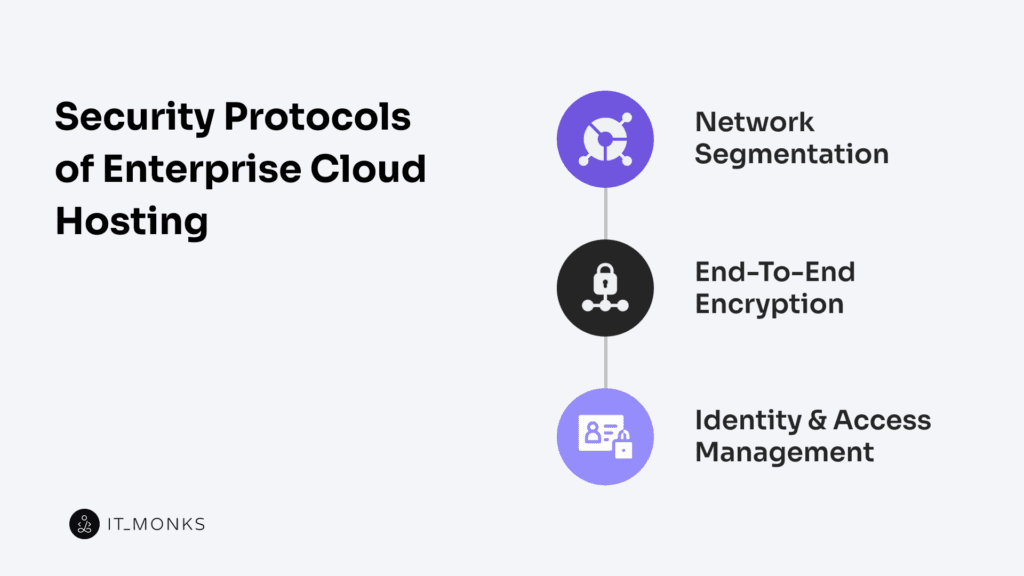
Security protocols in enterprise cloud hosting establish the rules, behaviors, and enforcement policies for infrastructure protection, data integrity, and access control. This protocol-based enforcement operates across network, data, and identity layers to ensure systematic isolation, validation, and restricted access.
These multi-layered enforcement systems are architected into the cloud infrastructure from the substrate up. The primary function of security protocols is to govern how data is transmitted, accessed, partitioned, verified, and logged under operational load, with enforcement zones embedded around the most sensitive and business-critical functions of enterprise workload environments.
Security protocols enforce isolation and protection at the network level through segmented routing domains and policy-driven traffic filters that adhere to Zero Trust Architecture (ZTA) tenets. Each enterprise workload is placed within isolated network zones, reducing lateral movement and enforcing explicit trust validation for every packet crossing system boundaries.
This segmentation follows ZTA principles and aligns with compliance-driven security rules such as HIPAA, SOC 2, and PCI-DSS, enforced through cloud-native security orchestration mechanisms.
At the data protection layer, transport and storage encryption protocols are applied using hardware-accelerated and software-defined cryptographic operations. These protocols validate data integrity during transit and confirm immutability at rest.
Integration with enterprise-grade key management systems (KMS) restricts encryption key usage to authenticated, authorized roles. Encryption is a codified enforcement mechanism for enterprise websites processing proprietary systems, financial data, and customer records under SOC 2 and ISO governance.
Security protocols enforce identity and access management (IAM) frameworks that validate user access through multi-factor authentication, attribute-based enforcement, and behavioral telemetry.
These access control frameworks restrict operations based on user roles, functional policies, and historical patterns. Role-based access enforcement restricts system behavior via end-to-end policy governance, with every interaction logged into telemetry pipelines for immutable auditing.
Such layered enforcement domains, network segmentation, end-to-end encryption, and identity governance are foundational to enterprise-grade cloud hosting. For enterprise websites operating under strict regulatory and operational demands, these security layers are embedded prerequisites for scalable, auditable, and trusted digital infrastructure.
Network Segmentation
Network segmentation is a critical, policy-enforced architectural layer that isolates systems, services, users, and environments in enterprise cloud hosting. This network partitioning defines how virtual private clouds (VPCs), subnets, and micro-segments structure enterprise cloud environments, aligning each zone with a specific trust boundary, such as separating production, staging, and development layers.
By isolating these operational areas, segmentation restricts east-west traffic and enforces intra-zone vs. inter-zone boundaries to minimize the risk of lateral movement during breach attempts.
Security zones are configured through access control lists (ACLs), firewall rules, and software-defined network (SDN) policies, each of which enforces ingress/egress control and subnet boundary enforcement. VPC-level micro-isolation restricts access between workloads, while inter-service firewalling defines allowable communication paths between front-end and back-end systems.
Enterprise cloud infrastructure enforces these definitions to isolate third-party service access, often gating them to tightly scoped subnets through zero trust perimeter policies.
Subnet segmentation enforces cross-zone ACL mapping and Layer 3/Layer 4 rule sets to contain threats and reduce the overall attack surface. Segmentation also monitors ingress/egress pathways through auditable access logs and real-time anomaly detection, placing control mechanisms directly into the routing layer. Through east-west traffic control, segmentation enables containment policies that localize intrusion attempts and maintain operational continuity.
As a strategic control layer, it governs how infrastructure boundaries align with policy-defined trust zones. Within enterprise security protocols, network segmentation functions as a foundational enforcement tier. It precedes and integrates with encryption, which secures the flow of data inside and between these zones, and identity & access management, which determines which identities can access which segment under which policy.
End-to-End Encryption
End-to-end encryption is a non-negotiable, systemic enforcement mechanism for securing data in transit and at rest across enterprise cloud environments. It encrypts data at its origin point and decrypts it only at the intended destination, governing confidentiality enforcement across every layer of communication, between users, APIs, application services, microservices, and third-party interfaces.
No intermediary, including CDN edges, proxy nodes, or internal service mesh components, accesses the raw payload, as Transport Layer Security (TLS 1.3) and application-layer encryption restrict plaintext visibility during data in transit.
Cloud workload communication is secured using mutual TLS (mTLS), which validates both endpoints through certificate-based mutual authentication. This handshake enforces encrypted data channels, not just externally but across internal service-to-service messaging as well.
KMS infrastructure governs the encryption key lifecycle, applying automated key rotation intervals and HSM-backed storage mechanisms to secure cryptographic material at rest and in transit. Role-based access defines which identity or system component can access which encryption key, preventing unauthorized decryption operations across isolated workloads.
Encrypted object storage, full-disk encryption, and database-layer encryption protocols (e.g., AES-256) protect data at rest within cloud-native service environments. These encryption layers are applied to virtual disks, cloud blob storage, and relational databases to maintain confidentiality even in the case of unauthorized physical access or snapshot cloning.
The application stack enforces API-level encryption, transmitting sensitive fields, credentials, PII, and transactional records within a tightly governed end-to-end encryption pipeline.
Enterprise key management systems integrate with hardware security modules (HSMs) to validate, rotate, and restrict key usage across workloads and geographies. Cross-cloud or hybrid deployments maintain encryption consistency using centralized KMS policies and cloud-agnostic key orchestration systems, sustaining a verifiable encryption state across all regions and service meshes.
End-to-end encryption protects enterprise websites and cloud applications from lateral movement, session hijacking, and man-in-the-middle attacks. It functions as the data-layer counterpart to network segmentation, which isolates infrastructure paths, and IAM, which restricts user roles and permissions. Together, these layers establish an interdependent security framework aligned with compliance baselines, including GDPR, HIPAA, and SOC 2, where encrypted data flows and verifiable key custody support provable confidentiality across the full data lifecycle.
Identity & Access Management
Identity and access management is the user-, system-, and service-level gatekeeping protocol that governs all interactions within an enterprise cloud environment. IAM enforces these controls through cloud-native policies that define who can access which resources, under what conditions, and for how long.
IAM authenticates users, services, and machine agents, and restricts access based on identity type, context, and environmental signals. It enforces entry permissions, operational scopes, and conditional logic across all identity vectors.
Identity and access management policies authorize actions on cloud resources using Role-Based Access Control (RBAC) and Attribute-Based Access Control (ABAC). RBAC assigns fixed permissions to roles such as admin, developer, or read-only, while ABAC enforces dynamic rules based on device, location, or login time, supporting granular, time-bound access scopes and role hierarchy enforcement.
Federated identity systems authenticate enterprise user accounts across cloud and internal systems via SAML, OAuth, and OIDC handshakes. These systems bind identities to cloud-native access tokens, validate every session against IAM policy, and integrate with corporate SSO platforms to streamline secure access.
IAM enforces multi-factor authentication (MFA), triggers token expiration, and logs every session interaction, ensuring traceable, revocable access to all services. Scoped resource permissions are evaluated in real-time, and all access attempts are logged for audit visibility and regulatory compliance.
Identity and access management governs encryption key access and regulates entry into segmented network zones, ensuring policy-aligned access across the security stack. As a mandatory enforcement layer in regulated enterprise environments (HIPAA, SOC 2, GDPR), IAM delivers identity-bound control over every cloud interaction.
Compliance and Governance of Enterprise Cloud Hosting
Compliance and governance are an active, policy-enforced layer of enterprise cloud hosting that ensures hosted workloads conform to legal, regulatory, and organizational standards. These controls enforce infrastructure governance through policy-as-code, continuous compliance validation, and configuration drift detection.
Governance frameworks, including NIST, CIS, and ISO 27001, define configuration baselines across access control, data flow, and logging. Simultaneously, regulatory standards such as HIPAA, PCI-DSS, GDPR, and SOC 2 are mapped directly into enterprise cloud policies, dictating how systems are provisioned, monitored, and audited across the control plane.
Enterprise cloud hosting environments automate compliance using scanning tools that monitor policy adherence, validate changes pre-deployment, and document activity through audit log aggregation. These enforcement layers create attestation workflows and traceable records for internal and third-party audits.
Governance extends to all technical domains, storage, identity, access management, network segmentation, and disaster recovery, remediating drift and preserving a continuous compliance posture, not a one-time event.
Such a posture relies on configuration baselines, regulatory zone mapping, and attestation workflows that embed jurisdictional integrity and validation trails across the control plane.
Enterprise cloud policies ensure that hosting environments maintain regulatory alignment across every infrastructure layer, integrating risk assessment, SLA enforcement, and contractual guarantees into the overall control framework.
Governance structures extend beyond internal enforcement to externally recognized assurances and geographic compliance mandates. Two key expressions of this governance system are Data Residency, which enforces jurisdictional boundaries on storage, and Industry Certifications, which validate compliance through third-party assessments.
Data Residency
Data residency is a regulatory and contractual enforcement domain that governs the geographic location of enterprise data within cloud hosting environments. It governs jurisdictional control to meet regulatory or contractual mandates, especially for sensitive data such as PII, health records, or financial transactions.
Regional cloud infrastructure restricts storage and compute operations to designated zones through region-locked buckets, geo-fenced analytics, and localized replication policies. These architectural controls support legal compliance by preventing unauthorized jurisdictional transfers in violation of regulations such as GDPR, HIPAA, or LGPD.
These controls prevent cross-border data exposure and align with compliance triggers like GDPR, HIPAA, LGPD, and FISMA.
Sovereign cloud platforms isolate data within jurisdiction-specific stacks, such as EU-only environments, to meet country-specific legal standards. These sovereign infrastructure zones are built to comply with country-specific regulatory flags and residency mandates.
Encryption key management is scoped to residency zones, and access policies enforce cross-border access control by prohibiting unauthorized administrative activity across jurisdictions.
Enterprise compliance policies map residency requirements directly to infrastructure behavior. This includes residency-aware tagging systems, region-bound infrastructure modules, and jurisdictional logic embedded into deployment pipelines.
Cloud-native tagging, jurisdiction-aware deployment code, and region-bound controls act as enforcement layers, ensuring that residency compliance is embedded by design.
Data residency supports the broader compliance posture by limiting legal exposure and satisfying audit criteria tied to industry certifications.
Industry Certifications
Industry certifications are formal third-party validations that an enterprise cloud hosting platform meets specific regulatory, security, and operational standards. These certifications attest that hosting providers enforce control frameworks aligned with their defined regulatory scope.
SOC 1, SOC 2, and SOC 3 certifications assess control verification domains including data availability, confidentiality, and integrity. ISO/IEC 27001 confirms the presence of an information security management system, covering encryption enforcement, access control, and incident response.
PCI DSS enforces encryption protocols and mandates audit trail inspection for financial data handling. HIPAA and HITECH map to healthcare data protection frameworks, validating breach response enforcement and internal access policy implementation.
Certification bodies apply an audit coverage matrix to assess hosting environments, examining infrastructure availability, incident handling, encryption, access logging, and policy enforcement. Certifications like FedRAMP, HITRUST, CSA STAR, GDPR compliance marks, TISAX, and FISMA attest to regulatory framework mapping across government, enterprise, and sector-specific operational standards.
Each certification represents a certification audit that confirms internal policy alignment and technical safeguard enforcement against regulatory scope. Certification bodies assess infrastructure availability, change management procedures, IAM, and system monitoring controls. These audits follow an annual recertification interval, requiring continuous control monitoring and documented compliance evidence.
The independent auditor scope defines the depth of technical control assessment, including change logs, system access trails, and recovery tests tied to the certification scope. For governance frameworks, industry certifications validate compliance alignment by serving as external enforcement layers.
They provide audit proof, support risk scoring, and determine deployment eligibility in regulated environments. Hosting providers without current certifications risk exclusion from procurement pipelines or increased scrutiny during compliance audits.
Integration Stack of Enterprise Cloud Hosting
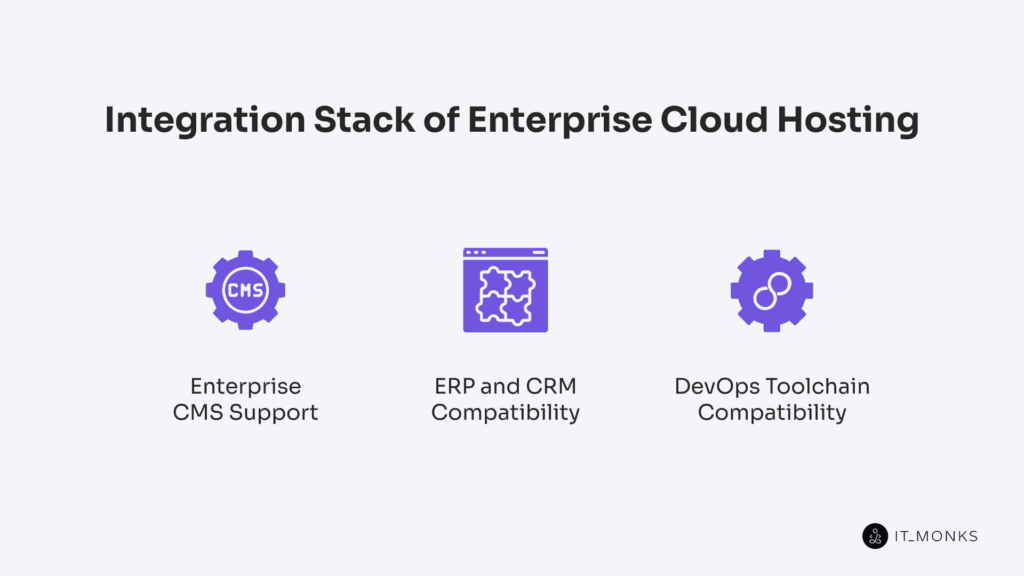
The integration stack is the structural layer that supports seamless interoperability between the enterprise cloud hosting environment and the tools, platforms, and systems that enterprise operations depend on. It defines the capabilities that allow hosted applications to connect, operate, and synchronize with external business systems and internal development tools.
Hosting platforms orchestrate integration via API orchestration layers, runtime service interfaces, and containerized middleware components that expose modular, extensible architecture behaviors. These interface layers expose programmatic access points through RESTful APIs, webhooks, and SDKs, while enabling event-driven message routing via asynchronous queues like Kafka and RabbitMQ. As a result, enterprise cloud infrastructure provisions runtime connectors and interface mappings to enable interoperability with CMSs, ERPs, CRMs, and DevOps pipelines.
The integration stack orchestrates system interoperability by exposing service endpoints that synchronize data operations between decoupled components. Application interfaces facilitate custom logic deployment via container-based runtimes directed by frameworks like Kubernetes.
Middleware components orchestrate asynchronous traffic routing, enable real-time telemetry collection, and maintain CI/CD hooks across distributed microservices. These middleware agents also provision backward-compatible bridges to legacy systems through integration gateways and custom translation layers.
Enterprise hosting platforms provision pre-built connector modules for content management systems like WordPress VIP, Sitecore, and Adobe AEM. These modules enable automated CMS deployment across multi-instance environments, aligning with headless and decoupled architecture needs.
Similarly, enterprise platforms provision API modules and SDK frameworks that enable ERP and CRM integration with SAP, Salesforce, and Microsoft Dynamics, ensuring architecture compatibility. For development operations, hosting platforms orchestrate CI/CD integration via native support for Jenkins, GitLab, and Terraform, while facilitating observability through Datadog and related telemetry tools.
Application-level modularity, event handling logic, and third-party system integration are structural necessities for modern enterprise workloads. These integration functions support distributed environments, dynamic scaling, and data consistency across independently managed services. As such, the integration stack is an embedded layer that facilitates middleware orchestration, container runtime control, and development process synchronization.
What follows are the specific layers of CMS support, ERP and CRM compatibility, and DevOps toolchain integration that structure the complete interoperability schema of enterprise cloud hosting.
Enterprise CMS Support
Enterprise CMS support in cloud hosting orchestrates the deployment of modular content platforms into scalable infrastructure with an API-first delivery model and frontend-backend decoupling. Enterprise CMS platforms deploy in containerized environments and support headless front-end architectures using frameworks like React and Next.js.
The hosting environment provisions isolated runtimes and routes content through CDN-backed delivery with edge caching and real-time preview integration. These CMS platforms operate over a structured content repository, ensuring modular reuse across multi-channel delivery pipelines.
API gateways connect backend services and enable API-driven structured content management, persistent media storage, and metadata routing. Editorial workflow systems integrate with CI/CD pipelines to automate staging and publishing environments, enforce role-based content approvals, and manage version control.
Content orchestration spans multi-site deployments, supports regional failover, and integrates with ERP and CRM platforms for personalization logic and data synchronization. DevOps toolchains manage deployment pipelines, treating CMS platforms as programmable, scalable components within the broader enterprise integration stack.
ERP and CRM Compatibility
ERP and CRM compatibility in enterprise cloud hosting integrates secure, real-time workflows with business systems through authenticated APIs and structured data orchestration.
ERP systems like SAP S/4HANA, Oracle ERP Cloud, Microsoft Dynamics 365, and NetSuite synchronize operational records, financials, HR, and inventory, while CRM platforms such as Salesforce, Zoho CRM, and HubSpot propagate customer interactions and engagement data. Hosting infrastructure orchestrates integration by managing a middleware layer that authenticates sessions, transforms data formats, and controls sync behavior.
APIs, RESTful and SOAP, serve as the primary interface layer, enabling API handshake and authentication protocols that govern access and data flow security. Hosting platforms enforce API authentication using OAuth2 and SAML to enable identity federation, while enforcing rate limits and error handling with retry logic.
Role-based access rules define what data and how it flows. Transactional data reconciliation ensures that synchronized financials, HR, and customer records remain consistent across ERP and CRM boundaries.
Business logic engines orchestrate schema transformation and align transactional processes across systems, handling both real-time triggers and batch ETL pipelines depending on sync requirements.
Event-driven architecture supports asynchronous data sync using queues like Kafka and RabbitMQ. The middleware orchestration layer translates EDI, manages webhook payloads, and ensures identity and session propagation across platforms. CRM platforms initiate identity sessions that propagate into ERP dashboards without requiring re-authentication, maintaining federated access control.
The hosting environment’s middleware support includes Kafka brokers for queue management, transformation engines for schema normalization, and EDI gateways for structured B2B communication.
Compatibility includes data integrity enforcement, version-controlled updates, and compliance-driven access policies. This integration layer directly feeds enterprise CMS personalization engines and triggers DevOps deployment workflows, making ERP and CRM alignment a foundational requirement, not a convenience.
DevOps Toolchain Compatibility
DevOps toolchain compatibility is the hosting platform’s ability to integrate seamlessly with the full stack of DevOps tools used for source control, build automation, testing, deployment, monitoring, and rollback.
This compatibility orchestrates system-wide continuity between code commits and live deployments through runtime-executable CI/CD pipelines, container orchestration engines, and policy-enforced infrastructure modules.
The hosting infrastructure provisions deployment environments using infrastructure-as-code modules that validate Terraform configurations, apply policy-as-code constraints, and restrict provisioning to authorized DevOps identities. GitOps workflows trigger API-driven builds and auto-synchronize repository states with live environments, ensuring configuration parity through versioned declarative states.
CI/CD pipelines execute controlled build and release processes via native artifact registry integrations. The pipelines expose container registries, control image promotion stages, and apply pipeline execution logic bound to role-specific access controls. These controls segregate operational scopes across environments, preventing privilege creep and deployment drift.
Containerized workloads are orchestrated through Kubernetes or equivalent schedulers, governed by Helm charts and runtime policies. Blue-green deployment orchestration, canary pipelines, and automated rollback logic are natively supported by the environment’s orchestration layer, ensuring high availability during progressive releases.
Observability frameworks integrate monitoring agents to trace, log, and correlate events across the deployment lifecycle. Real-time trace collection, alerting, and error propagation are embedded into the runtime fabric, allowing incident response to act on telemetry without delay. Secrets are managed via tokenized vaults, exposing ephemeral credentials per stage with revocation hooks, audit logs, and rotation policies.
Security scanning pipelines validate container images and artifact chains using tools like SonarQube or Snyk, enforced pre-deployment via policy modules. The hosting platform applies DevSecOps principles across the stack, ensuring image integrity, static code compliance, and dependency risk scoring as prerequisites for promotion.
This orchestration layer aligns DevOps operations with platform governance through entity-indexed traceability, role-bound execution rights, and declarative environment control.
As a result, enterprise CMS and ERP systems can initiate content deployment or data syncs through traceable, versioned automation hooks, keeping continuous publishing and system updates integrated under one governed toolchain.
Deployment Models of Enterprise Cloud Hosting
Deployment models in enterprise cloud hosting define how infrastructure resources are provisioned, isolated, and managed to meet performance, compliance, and integration requirements. These enforce architectural decisions that govern resource segmentation, dedicated control plane behavior, and workload orchestration logic across cloud environments.
Hosting architectures provision deployment models around compliance boundaries, access governance, and operational control. Public cloud, while scalable, provides limited tenant isolation boundaries and control scope, making it a poor fit for regulated enterprise workloads. In contrast, private and hybrid models are adopted for their ability to enforce isolation strategies, govern control layers, and align integration behavior with existing systems.
Private cloud provisions single-tenant environments with isolated networks and dedicated resources. Control layers in private cloud architectures govern policy enforcement, orchestration flow, and internal routing logic through a dedicated control plane.
Enterprises adopt this structure to ensure deterministic performance, data locality enforcement, and region-bound compliance zoning. This represents a compliance-driven deployment, where policy-controlled access is hardcoded into infrastructure behavior.
A hybrid cloud integrates on-premise systems with cloud platforms, enabling multi-environment orchestration. It aligns virtual machine and container orchestration across control domains, while maintaining legacy system compatibility and supporting workload mobility. This integration depends on a dedicated on-premise integration layer that synchronizes cloud-native orchestration with internal infrastructure.
Hybrid environments also support disaster recovery models by replicating critical workloads across segmented environments, ensuring resilience and SLA enforcement boundaries. They further enable consistent identity management and security, and compliance zoning across enterprise workloads.
Multi-cloud deployments, while sometimes referenced, are distinct. They distribute workloads across providers without unified orchestration layers, lacking the integration continuity that defines hybrid architectures and weakening architectural cohesion.
Deployment models govern how enterprise workload structures operate, provisioning infrastructure, orchestrating workloads, enforcing compliance boundaries, and integrating control across environments. Among the available options, private and hybrid models dominate, supporting the isolation, interoperability, and enforcement capabilities required by enterprise website hosting strategies.
Private Cloud
Private cloud is an enterprise deployment model where hosting infrastructure is dedicated to a single organization, providing full control over resource provisioning, security enforcement, and network isolation. It provisions a dedicated virtualization fabric, configurable orchestration engine, and SLA-tiered infrastructure stack that collectively enforce strict resource boundary controls across compute, storage, and network planes.
Private cloud segments workloads through single-tenant network segmentation, either physically or logically, to eliminate cohabitation risks found in public cloud models. It configures the control plane for full-stack orchestration and enforces governance-layer customization through enterprise-defined compliance architectures.
Policy injection is executed via policy-as-code mechanisms, allowing tailored enforcement of security protocols, data flows, and resource usage thresholds.
Private cloud deploys its virtualized infrastructure stack on-premises or within provider-dedicated environments, enforcing regulatory boundaries through compliant platforms like Azure Stack, OpenStack, or VMware Cloud Foundation. It customizes IAM layers and policy engines to reflect enterprise-specific governance models, supporting regulatory scope enforcement such as HIPAA, FedRAMP High, and PCI-DSS.
The infrastructure supports legacy workload accommodation and custom workload integration, including mainframe VM compatibility, by orchestrating tailored blueprints mapped to SLA constructs.
This includes metadata isolation, traceable telemetry injection, and data residency enforcement aligned with audit-intensive governance frameworks. These blueprints are optimized for SLA-tiered resource allocation and telemetry-based observability stacks.
Private cloud isolates all systems and workflows within a single-tenant boundary, unlike hybrid cloud configurations that orchestrate across shared zones. Such a deployment model maximizes control plane sovereignty, compliance architecture enforcement, and workload predictability across the enterprise hosting environment.
Hybrid Cloud
Hybrid cloud is a deployment model where enterprise workloads are strategically distributed between on-premise or private cloud environments and public cloud services, enabling controlled scalability, integration continuity, and regulatory segmentation. Hybrid cloud distributes enterprise workloads based on governance policies, regulatory boundaries, and legacy anchoring, and extends runtime access to cloud-native scalability and SaaS integration.
The control plane federates identity propagation, workload orchestration, and observability using tools like Azure Arc, AWS Outposts, and Google Anthos. These platforms synchronize policy engines, enforce role propagation, and align configuration states across environments using infrastructure-as-code and policy-as-code models.
Hybrid cloud bridges environments through a service mesh layer that enforces secure API routing and synchronizes real-time data across stacks. Federated IAM systems propagate access control and identity roles across stacks, maintaining governance alignment. Cross-environment CI/CD pipelines enforce consistent deployment logic, while hybrid DNS and failover routing extend disaster recovery operations across cloud boundaries.
Edge computing sites integrate with centralized control systems to provision regional processing under global policy enforcement. Hybrid cloud governs multi-environment architecture, not for flexibility but for structured integration between legacy infrastructure and cloud innovation under strict compliance and control.
Top Enterprise Cloud Hosting Providers
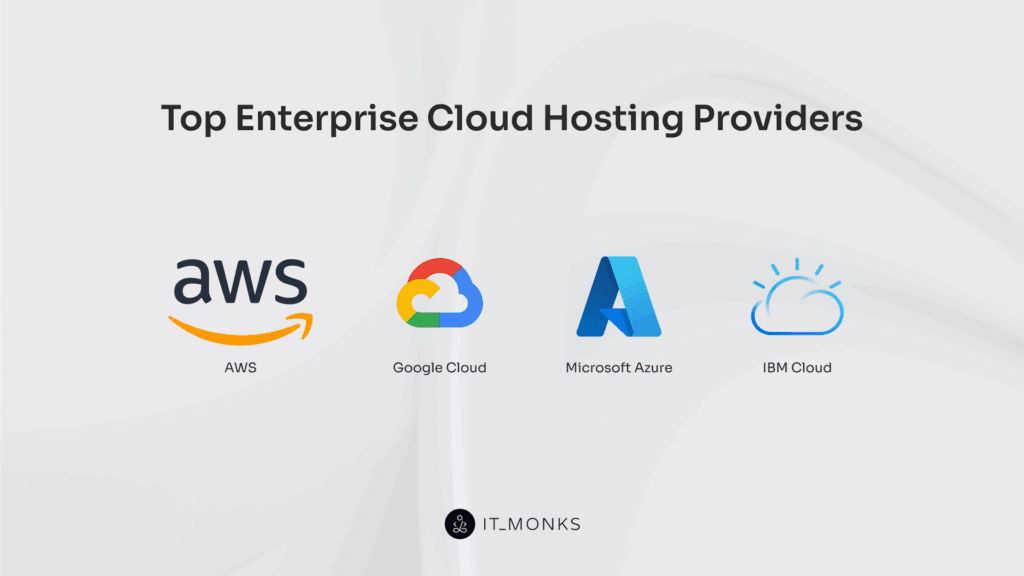
AWS
AWS is a leading enterprise cloud hosting provider, focusing on its infrastructure architecture, compliance alignment, service orchestration capabilities, and operational scalability.
The compute environment scales enterprise applications via EC2 instances, ECS for containerized services, and EKS for managed Kubernetes orchestration, each enabling elasticity across availability zones. Storage architecture integrates S3 for object retention, EBS for block persistence, FSx for Windows-native applications, and Glacier for cold archiving, allowing multi-tiered data governance.
Cloud networking layers isolate traffic through VPCs, enforce transit policy via Transit Gateway, and replicate connectivity through Direct Connect. These components segment infrastructure to optimize latency, throughput, and policy-based routing between on-prem and cloud systems. IAM frameworks enforce policy-based access control through identity federation, inherited permissions, and organization-wide SCPs.
AWS organizations enforce policy propagation across multi-account setups. Cross-account governance is maintained via AWS organizations, unifying service controls across environments.
Governance engines maintain compliance alignment with FedRAMP High, HIPAA, PCI DSS, and ISO 27001 standards. AWS Control Tower automates environment provisioning while Config audits configuration drift. API-driven provisioning enables infrastructure deployment consistency through CloudFormation, CDK, and Terraform templates.
Hybrid deployment models replicate segmented infrastructure locally via Outposts and extend VMware-based systems using VMware Cloud on AWS, preserving workload affinity while centralizing observability. The Monitoring Stack orchestrates observability instrumentation through CloudWatch, X-Ray, and CloudTrail, delivering telemetry and traceability across services.
AWS infrastructure delivers region-based service availability, auto-replicates workloads with multi-zone failover, and orchestrates disaster recovery through cross-region deployment strategies. Service integrations span API Gateway for front-end routing, Lambda for event processing, and RDS and DynamoDB for transactional state, each binding enterprise applications into CI/CD pipelines, ERP layers, and CMS backends.
This distributed control plane binds enterprise-grade integration across CI/CD pipelines, ERP backends, and CMS systems through secure, policy-aligned service orchestration. Through structured orchestration, policy enforcement, and integration-ready services, AWS governs workload scalability and enterprise segmentation across a distributed, compliance-aware control plane.
Google Cloud
Google Cloud Platform is an enterprise-class hosting platform that provides modular services across compute, storage, networking, identity, and AI-driven infrastructure.
Google Cloud infrastructure provisions containerized workloads across multi-region environments using Compute Engine (GCE), Google Kubernetes Engine (GKE), and Cloud Run. GKE, as a first-class orchestration layer, orchestrates Kubernetes-native scaling and workload portability, aligning with enterprise demands for hybrid and container-first deployments.
VPC Network Fabric segments workloads with secure boundary isolation using VPC Service Controls and Cloud Interconnect for low-latency, encrypted networking. Cloud Load Balancing distributes traffic dynamically across regional zones, supporting consistent service availability.
This behavior reinforces GCP’s multi-region compute provisioning model, supporting fault-tolerant service orchestration across geographically isolated zones. Persistent Disks, Filestore, and Cloud Storage tiers handle structured and unstructured data persistence, integrated into container-native workflows through deployment templates and orchestration layers.
IAM Framework enforces role-based segmentation and federated identity control. IAM Framework deploys policies through Org Policy and VPC Service Controls to govern access at both service and project levels. BeyondCorp and Identity-Aware Proxy instantiate a zero-trust identity layer, isolating access through context-aware authentication and authorization. This federated policy architecture enforces fine-grained controls over both internal and external identity providers.
Anthos control layer integrates hybrid and multi-cloud orchestration, deploying enterprise workloads across on-premises and third-party clouds. Anthos federates control, governance, and security configurations consistently across clusters, aligning with policy-as-code standards for unified infrastructure governance. These governance configurations are codified through policy-as-code principles, ensuring reproducible and version-controlled enforcement.
AI/ML Service Stack integrates scalable compute with analytics-native tooling. Vertex AI hosts production-grade ML pipelines, while BigQuery ML and AutoML support enterprise data ops with embedded model training capabilities.
These ML runtimes integrate directly with GCP’s observability stack, cloud monitoring, logging, trace, and profiler, to surface performance metrics across distributed systems. This integration ensures that model performance, resource utilization, and pipeline latency are continuously observable within GCP’s runtime infrastructure.
Together, Google Cloud Infrastructure orchestrates enterprise hosting through secure identity enforcement, container-native operations, and data-aligned ML integration, positioning it as a strategic fit for identity-sensitive, analytics-driven workloads.
Microsoft Azure
Microsoft Azure is a modular, enterprise-centric cloud platform engineered for compliance-intensive, hybrid-integrated, and identity-governed deployments. Azure provisions compute infrastructure through Virtual Machines, App Service, and Azure Kubernetes Service (AKS), enabling high-performance application hosting across modular enterprise environments.
Its storage ecosystem, comprising Blob Storage, Disk Storage, and Azure Files, governs data persistence and scales across structured, semi-structured, and unstructured layers to align with enterprise-grade workload segmentation.
Azure’s networking stack governs internal and external connectivity via Virtual Network (VNet), ExpressRoute, Load Balancer, and Private Link, enforcing enterprise traffic policies through region-bound segmentation and private endpoint configurations.
Azure Active Directory (AAD) federates access controls across hybrid and multicloud environments using Conditional Access policies and a tightly scoped RBAC enforcement model. AAD synchronizes with on-premises directories to sustain federated identity continuity across a hybrid infrastructure.
Azure Arc orchestrates hybrid deployments across on-premises, edge, and multicloud environments, preserving policy states via declarative templates and GitOps workflows. This policy-as-code template library enables consistent provisioning standards and pre-validated governance rules across deployments. Policy enforcement is governed through Azure Policy and Blueprints, and integrated with Defender for Cloud to secure the full workload lifecycle.
For enterprise observability, Azure Monitor, Log Analytics, and Application Insights expose telemetry pipelines that support root cause diagnosis and performance benchmarking at scale. These observability pipelines form a unified monitoring layer that reinforces hosting performance benchmarks and real-time compliance signals for enterprise-grade deployments.
Microsoft Azure mitigates infrastructure drift and accelerates provisioning workflows through Infrastructure-as-Code (IaC) tools like ARM templates, Bicep, GitHub Actions, and Terraform, forming a declarative-first DevOps control plane. Its compliance-grade infrastructure supports region-specific governance models, including Azure Government and China regions, mapped to certifications such as SOC 2, ISO 27001, FedRAMP, GDPR, and HIPAA.
Microsoft Azure governs identity-centric, compliance-certified, and hybrid-resilient enterprise deployments through directory federation, region-bound controls, and policy-as-code automation, making it architecturally distinct for enterprises with deep entrenchment in Windows Server ecosystems and legacy infrastructure.
IBM Cloud
IBM Cloud is a specialized enterprise hosting provider built for compliance-heavy, data-residency-controlled, and performance-isolated workloads.
IBM Cloud Infrastructure provisions bare-metal servers and virtualized instances through IBM Virtual Servers and Bare Metal Servers, and segments compute resources with precision-based isolation.
The compliance enforcement layer governs data residency policies and audit frameworks through IBM Cloud Security and Compliance Center. It segments workloads across security enforcement zones and aligns configurations with regulatory frameworks, including GDPR, HIPAA, PCI DSS, and FISMA.
IBM Cloud Infrastructure isolates workloads within virtual private cloud environments and provisions multizone failover configurations to ensure continuity under region-level disruptions. The Kubernetes orchestration layer orchestrates containerized deployments through Red Hat OpenShift and IBM Cloud Kubernetes Service. It aligns hybrid workloads across multizone regions and enforces integrated failover across distributed environments.
The hybrid control plane orchestrates multi-cloud resource distribution through IBM Cloud Satellite and preserves dedicated compute isolation during synchronization. The security and compliance engine enforces confidential computing mechanisms, including HSM-based key management and encryption of data in transit and at rest, through IBM Key Protect and Data Shield.
IBM Cloud integrates AI/ML workloads into its compliance-anchored architecture via Watson AI, aligning semantic models with compute behavior and optimizing enterprise workload execution. IBM Cloud integrates Power Systems virtual machines to preserve legacy enterprise compatibility and governs infrastructure continuity without compromising control or compliance scope.
IBM Cloud Infrastructure integrates legacy system hosting, hybrid orchestration, and governance-enforced security, positioning itself as the hosting standard for finance, healthcare, and public sector systems that demand regulatory-grade control.
Contact
Don't like forms?
Shoot us an email at [email protected]

